Bazaar of Kashan: Photos, History, Address, What to buy
Kashan has forever been one of Iran’s highly admired destinations for all explorers who are enthusiastic about antiquity. This esteemed picturesque city bearing numerous places of interest is situated on the northern side of Isfahan province in the central region of Iran. Within the heart of Kashan is the historical Bazaar of Kashan, a delicate work of masterful artistry which represents the grandeur of the cityscape. Here, you will discover the history, the architecture, and the precious souvenirs you can shop for in the Kashan Grand Bazaar. Stay with Matinabad to the end of this article.
The Grand Bazaar in Kashan
A place full of rich history and tradition with thousands of items to purchase and taste will surely leave an impact on you. Kashan bazaar, with a span of three kilometers, is filled with historical works and vibrant shops with all types of cultural goods, from sweets and nuts to shoes, carpets, and coppersmith utensils.
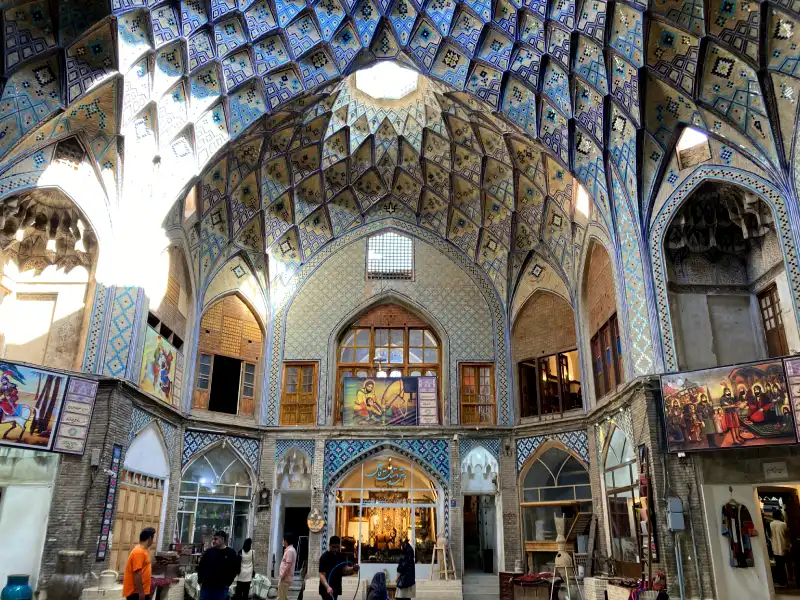
Annually, a great number of tourists come to sightsee the Kashan Great Bazaar together with its unique architecture and background; it truly is a national treasure in the country.
The historical Bazaar of Kashan boasts a multitude of monuments that are built together in a row as you stroll around the area. It has forty historical relics in total.
Some of these popular structures are the caravanserai, Borujerdi House, the Mosque of Mir-Emad Square, Mir-Panj caravanserai, Ghaffarpur, the famous warehouse of Amin od-dowleh, Bakhshi warehouse, the Mianchal Bazaar, Seyed-Agha Warehouse, Bala Bazaar Cistern (a waterproof receptacle for holding water), Darb Zanjir Cistern, Hosseinieh Surakh Risman, the shoemaker’s Mosque, Bala Bazaar Mosque, and finally the Tamqachia Mosque.
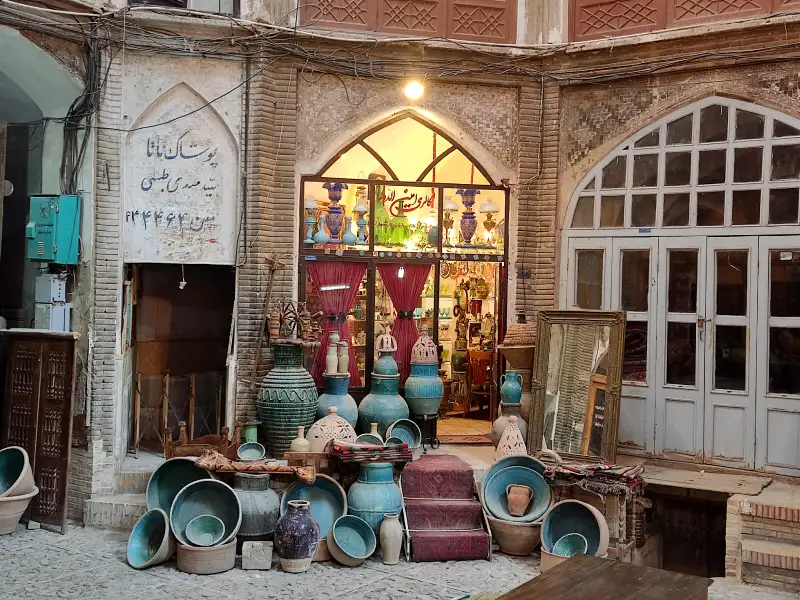
This traditional Bazaar is divided into sections based on the items and the profession of the shopkeepers. As you walk through the aged halls of the Bazaar of Kashan, you will come across various markets such as the coppersmiths, Dyed fabrics, shoemakers, thread and yarn, goldsmiths, tailors, Zarrabkhaneh (Mint) producing coins, and many more.
Hamam Khan is another fantastic spot to relax and enjoy your day. It served as a teahouse in the early days, but today it is a traditional restaurant welcoming visitors after a long walk.
A pool is in the center of the restaurant, and around it are platforms made for the diners to sit and enjoy their meal.
The History of the Kashan Grand Bazaar
The history of Kashan Grand Bazaar dates back hundreds of years, during the reign of the Persian king Fath-Ali Shah of the Qajar Dynasty (Seljukian Era).
During this era, trade and economic growth were booming. Thus, he began constructing the caravanserais, the warehouses, the mosques and schools, and the cisterns, which all made the great Bazaar of Kashan.
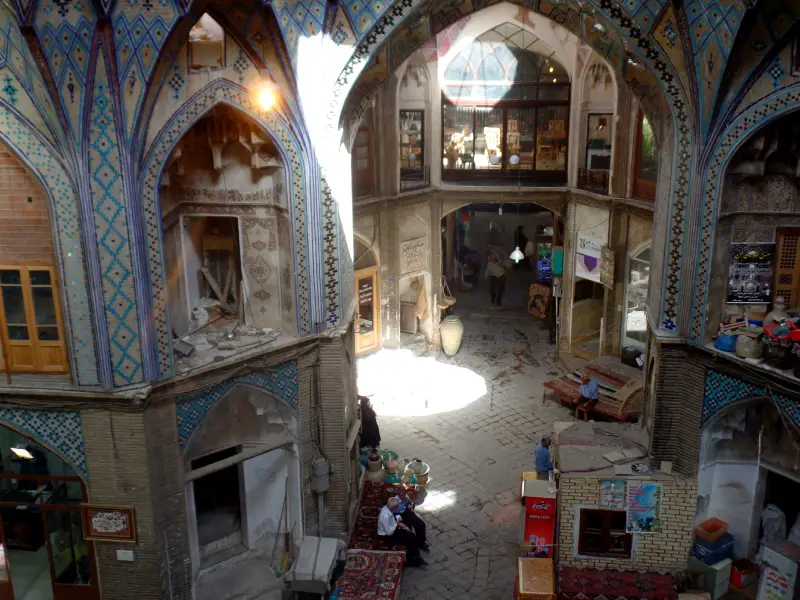
One of the finest locations in the Bazaar is the Amin od-dowleh Trade Arcade and the coppersmith market. In the early days of Persia, people would commonly use copper utensils due to their health benefits.
That is why, up to this day, the coppersmith market is highly acknowledged by Iranians, and they have preserved the tradition of making household items out of copper.
Inside the Amin od-dowleh warehouse, you will find more than twenty different double-story shops with various sizes and old balconies.
This warehouse extends from Darvazeh Dowlat or now by the name Shahrdari Square, up to Faiz Square, facing Masjid Square.
This warehouse is furnished with radiant handwoven Persian carpets with various textures and designs that are undoubtedly eye-catching for everyone.

In the early 1900s, the coppersmith bazaar almost collapsed due to the passing of Farrokh Khan, a high-ranking Persian official, until the Pahlavi dynasty was destroyed due to the modernization of the city part of the market. However, the culmination of the Bazaar’s excellence and opulence was in the Safavi Dynasty.
When you have decided to visit the historical Bazaar of Kashan, apart from sightseeing the coppersmiths, the goldsmiths, the cisterns, and the shoemakers’ markets, go through the Mianchal markets, the dying fabrics markets, as well as the Mint market. Each of these markets in the Bazaar was erected in a particular dynasty, and they have their own antique atmosphere.
In 1813, an Earthquake knocked down part of the Bazaar, which was later repaired and reconstructed by the order of Fath-Ali Shah.
Bazaar of Kashan Architecture
The Bazaar of Kashan holds more than a hundred and twenty shops with diverse colors and remarkable traditional goods.
Amidst the shops are several vast caravanserais that are parted by intersections with a large dome over each of these four-way pathways.
There is an opening on top of every dome to allow ventilation and bright sunlight to illuminate the Grand Bazaar. The intersections are endowed with defined artistic Persian architecture and decorations in both the ceilings and the walls.

In addition, the Bazaar of Kashan was assembled with extremely intricate geometrically shaped halls, and its architecture is greatly valuable since the bazaar has been active up to now.
The Bazaar has several pathways to walk through. There are the main pathways of the Bazaar, usually in a form of a straight line, which are also the largest roads.
Moreover, the shops are built in conjunction with the sides of the main paths. The minor pathways are built parallel or perpendicular to the main paths.
“Hojreh,” which translates to shop or chamber in Persian, is of two types in the Bazaar. The lower shops or Hojreh are open and used for selling goods to customers, and the upper Hojreh are offices for the staff and shopkeepers. The lower Hojreh has metallic doors, while the upper ones have wooden doors and windows.
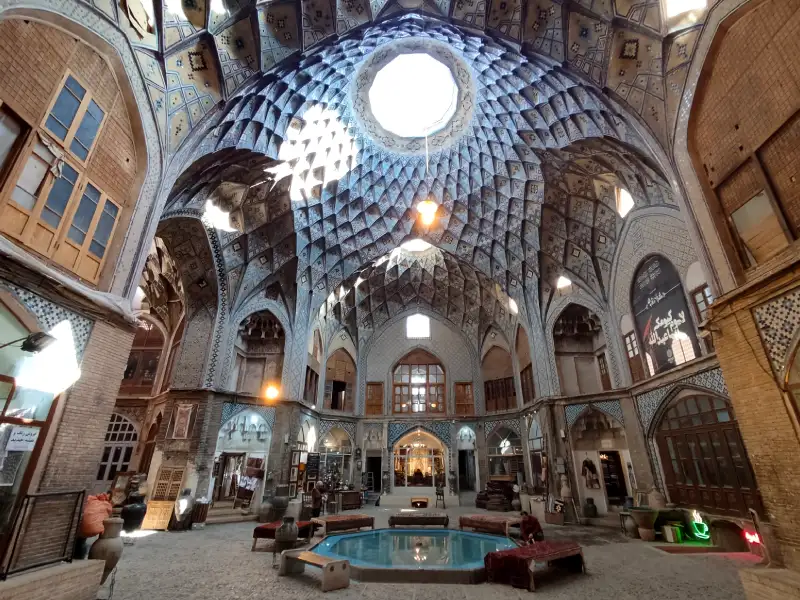
Some of the goods are distributed by commercial houses, called “Sara” in Persian, which are similar to wholesalers and are located inside the Bazaar of Kashan itself.
The craftsmen produce handmade products in bulk within these houses. They will then be imported to other sections of the Bazaar for purchase.
Two of the most famous Saras in the Kashan Bazaar are the Ganj-Ali Khaneh Kerman Sara and Vazireh Tabriz Sara.
What to buy in Kashan Bazaar?
If you have seen the bazaar of Kashan photos, you would already know about the perfect souvenirs you can buy while travelling in Iran.
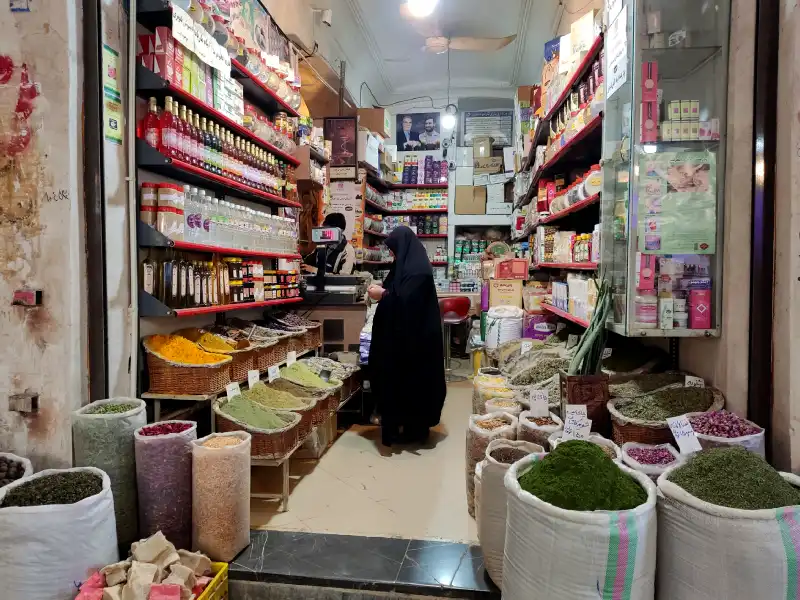
There are hundreds of items available for you to purchase Kashan Souvenirs!
- Copper Utensils
- Pottery
- Handmade Jewelry
- Shoes
- Colorful Tiny Tiles
- Carpets and Kashan Rugs
- Persian sweets and cookies
- Hajibadam
- Koluche
- Kashan Baklava
- Pashmak (Persian cotton candy)
- Abas-Ali Bread,
- Damask Rose Buds
- Rose water
- Other Herbal Extracts
You will discover more once you step into this scenic landmark.
Bazaar of Kashan Address
Today, with the main and auxiliary roads in the city, you can have easy access to the Grand Bazaar in Kashan. The Bazaar has two main entrances with the name “Baba Afzal” and “Darvazeh Dolat”.

Start from Kamal-ol-Molk Square and continue to the Baba Afzal Road, then from there, you can comfortably wander around this magnificent national treasure.
Last Words
The Grand Bazaar in Kashan will surely inspire you, and with its exceptional architecture and history, it still stands intact up to today. So be sure to visit this cultured national gem of Iran, and don’t forget to bring your camera with you to capture the most memorable moment of your life!
Are you planning to travel to Iran and looking for an Iran resort? Consider Matin abad eco resort. Maybe the things to do in Kashan are also interesting for you.





Leave a Reply
Want to join the discussion?Feel free to contribute!